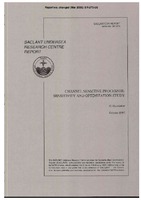| dc.description.abstract | The detection performance of the Channel-Sensitive Processor (CSP) has been tested in dense multipath conditions. It was demonstrated that, for a known propagation channel, the CSP outperforms the conventional matched filter technique. However, in an uncertain environment, the probability of detection decreases according to the degree of mismatch between the assumed and the actual channel characteristics. It was found that the processor is more sensitive to geometric parameters (source range and depth) than to environmental parameters (sound velocity profile, sedimentsubbottom interface, sediment thickness). To overcome the performance degradation due to channel mismatch, the CSP method was utilized in conjunction with two global optimization algorithms: the classical simulated annealing (SA) and a multi-layer simulated annealing (MUSA) method. At the expense of processing time, it has been found that the optimization methods reduce the channel mismatch effect and improve considerably the detection performance of the CSP. | |
